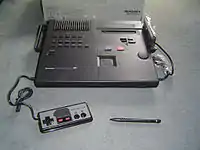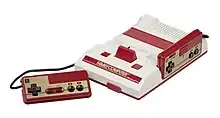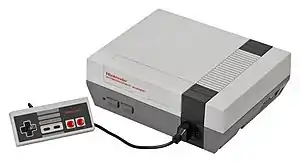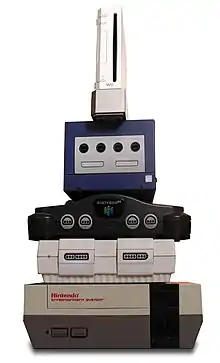Famicom Titler
The Famicom Titler (ファミコンタイトラー), also known as the Famicom Editor (編集ファミコン, Henshuu Famicom), is a Nintendo-licensed Famicom-compatible home video game console produced by Sharp Corporation in 1989. The console was released exclusively in Japan at a retail price of ¥43,000.[1] Intended for capturing footage of Famicom games, the system is noted for its crisp image clarity due to its internally-generated RGB signal and usage of S-Video for output.
 The Famicom Titler model AN-510. | |
| Manufacturer | Sharp |
|---|---|
| Type | Video game console |
| Release date |
|
| Introductory price | ¥43,000 |
| Media | ROM cassette |
| CPU | Ricoh RP2A03 8-bit processor |
| Storage | Battery backup |
| Graphics | Ricoh RP2C05-99 |
| Controller input | 2 controllers |
| Backward compatibility | NES |
| Predecessor | Twin Famicom |
| Successor | SF-1 SNES TV |
Overview
The Famicom Titler (AN-510) was the third Famicom-related device produced by Sharp during a period of close association between the company and Nintendo, following the C1 NES TV and the Twin Famicom.[1] The Famicom Titler was the most technologically ambitious project that Sharp had attempted with the Famicom system, with Sharp identifying a need for capturing direct game footage from a Famicom at a time when doing so for any video game required specialized equipment.[1] It is the only Famicom that was commercially available to internally generate RGB video, done via usage of a unique variant of the Picture Processing Unit (PPU) chip, and this has been identified as responsible for markedly improved clarity of image over other Famicom models.[2] It is also the only Famicom console to employ S-Video output, though composite video output is another option available on the system.[2] The system additionally features a keyboard and pressure-sensitive touchpad, enabling users to produce subtitles directly on the screen during gameplay as well as perform other basic editing functions, while a microphone is present to enable video narration.[1][3]
Because of a trademark dispute between Sharp and Nintendo over the word "Famicom", the Famicom Titler was one of the few versions of the Famicom to be officially labeled "Famicom" during its time on the market.[4]
Reception
Although relatively obscure at the time of its release, the console has recently seen increased interest from fans, hackers/modders, and collectors on the secondary market.[1][2] Apart from historical interest in the system, several features unique to the Famicom Titler make it a popular system for modification and use. The clarity that comes from internal RGB video generation is a prized feature shared only with the PlayChoice-10 system created by Nintendo as an arcade system for store displays and in video arcades; however, since the PlayChoice-10 is a significantly bulkier system that was never released commercially, the Famicom Titler is recognized by collectors as a more practical and attainable way to get a system with the same clarity.[1][5] In addition, the Famicom Titler is popular within the modding community as it is possible to easily modify the system to output a true RGB signal.[2]
References
- Plunkett, Luke (August 25, 2016) [October 28, 2015]. "The Nintendo Console From The 80s Made For Recording Gameplay Footage". Kotaku. G/O Media. Retrieved August 31, 2021.
- "Famicom Titler". Retro Gamer. No. 198. Future Publishing. September 5, 2019. p. 70. ISSN 1742-3155. Retrieved August 31, 2021 – via PressReader.
- Goulter, Tom (December 3, 2012). "The History of Console Redesigns: NES". GamesRadar. p. 2.
- McClain, K.J. (5 July 2018). "How Sharp Accidentally Copyright Trolled Nintendo Almost 40 Years Ago". Nintendo Life. Retrieved 11 February 2022.
- Burton, Phill (January 6, 2014). "Nintendo PlayChoice 10". Retro Gamer. Future Publishing. Retrieved August 31, 2021.


